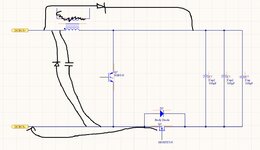fethiyeli
Full Member level 4
Hi Everyone,
Due to over-voltages in ac mains, I need to protect the DC Bus, especially the PFC bulk capacitors. I did some research and here what I have found. Mosfet for over-voltage protection has been using for low power battery powered applications as I see. However, I have never seen any application doing the same thing for PFC.
And also by this method, I want to get rid of the by-pass relay parallel with NTC or PTC on ac mains.
We are also able to disconnect the power stage via the mosfet on DCBus- in order to decrease the stand-by current.
Is that kind of protection logical ? I know I need to sense the current, input voltage, etc. Via extra winding, inductor current can be taken.
I know there are lots of experienced guys here. That's why, I wanted to get your opinions. Thank you.

Due to over-voltages in ac mains, I need to protect the DC Bus, especially the PFC bulk capacitors. I did some research and here what I have found. Mosfet for over-voltage protection has been using for low power battery powered applications as I see. However, I have never seen any application doing the same thing for PFC.
And also by this method, I want to get rid of the by-pass relay parallel with NTC or PTC on ac mains.
We are also able to disconnect the power stage via the mosfet on DCBus- in order to decrease the stand-by current.
Is that kind of protection logical ? I know I need to sense the current, input voltage, etc. Via extra winding, inductor current can be taken.
I know there are lots of experienced guys here. That's why, I wanted to get your opinions. Thank you.
Last edited:
